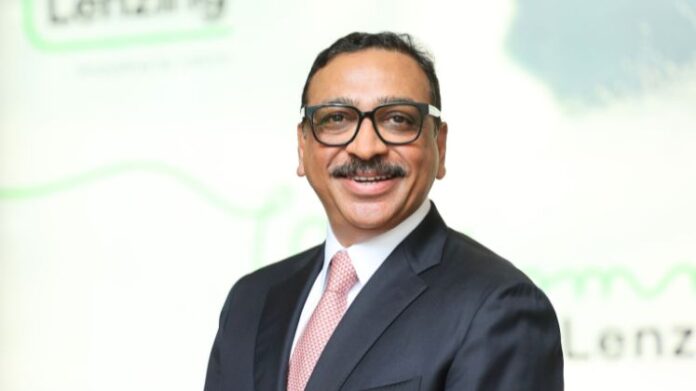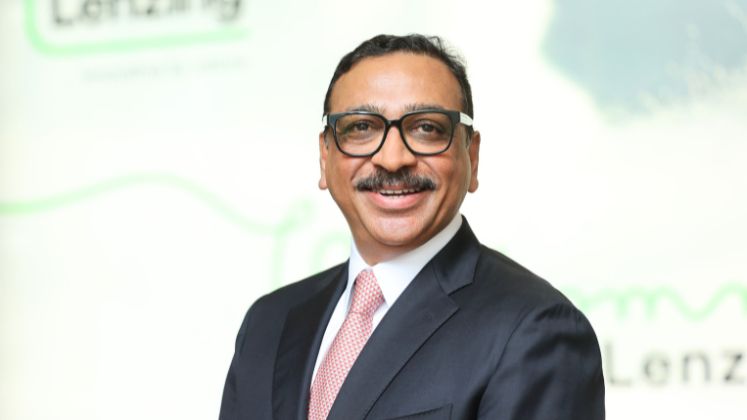Global markets and economies are undoubtedly facing challenges,” said Rohit Aggarwal, CEO, Lenzing, who recently took over after Stephan Sielaff. With decades of experience in the textile and chemical industries, Rohit brings with him a deep understanding of global markets and strategic development.
Rohit emphasised that India is a key market for Lenzing, a global leader in regenerated cellulose fibres for the textile and non-woven industries.
In an exclusive conversation with Apparel Resources, Rohit discussed Lenzing’s focus on sustainability, strategies for managing fluctuations in cotton prices and how the group expects to achieve higher EBITDA in 2024 compared to last year. Here are the edited excerpts.
AR: What are your insights on the current scenario and future outlook of the global fibre market?
RA: Global markets and economies are undoubtedly facing challenges. However, at Lenzing, we don’t shy away from headwinds, we instead strive to proactively adapt to the ever-changing industry landscape. Our customers and value chain partners remain at the heart of everything we do and we are doubling down our efforts to provide them with the collaborative innovation they need to thrive. Our decade-long experience in the sustainable fibre industry will continue to guide us through this challenging period and we will come out of this stronger than ever.
In the long run, the global fibre demand’s forecast looks promising. It is projected to reach 142 million tonnes, primarily fuelled by population growth and increasing per-capita consumption. The lyocell market, in particular, is expected to see a substantial 20 per cent growth rate per year, showcasing its immense potential.
Supply growth is expected to come almost exclusively from man-made fibres, owing to natural fibres’ supply constraints. Amongst man-made fibres, regenerated cellulosic fibres are poised to benefit from the increasing trend towards sustainability, which synthetic fibres cannot cater to. According to external sources, our addressable market of regenerated cellulosic fibres is expected to grow at about twice the market growth rate until 2030. We are continuously expanding our production capacity to ensure that Lenzing is ready to capitalise on this growth when markets recover.
AR: Lenzing has been known for its strong commitment to sustainability. What strategies or initiatives are you exploring to further advance sustainability?
RA: We are actively driving the transition towards a more sustainable textile industry with our ‘Naturally Positive’ sustainability strategy, a tri-pillar approach focusing on supply chain, circularity and systemic change.
To foster a greener supply chain, we ensure that our wood pulp is derived from certified or controlled sources. We leverage regular risk assessments, implementation of KPIs, audits and on-site visits as well as independent third-party certification of the sustainable forest management programs help to ensure the policy compliance and our commitment to no-deforestation.
On the circularity front, we strive to repurpose waste by co-developing circular solutions. A prime example is our LENZING™ ECOVERO™ fibres produced using the REFIBRA™ technology. This innovation combines pre- and post-consumer textile waste with wood pulp to create new fibres, using textile waste that could have otherwise ended up in landfills, while reducing the industry’s reliance on virgin materials.
In addition, our flagship specialty nonwovens brand VEOCEL™ is also helping brands and consumers to transition from synthetic materials to low-environmental impact alternatives. For instance, our VEOCEL™ Lyocell fibres with Dry technology offer an eco-responsible and quality alternative to fossil-based materials in personal hygiene products. The technology allows VEOCEL™ Lyocell fibres to achieve a high level of comfort, softness and dryness built on a biodegradable and botanic-derived material, which can be completely returned to nature after consumption. VEOCEL™ fibres are not classified as ‘plastic’ under the EU Single-Use Plastics Directive and offer a cellulose-based alternative for brands looking to develop plastic-free feminine and personal care products.
Adding to our efforts, we partner with key stakeholders such as Textile Exchange, Cascale, Canopy, Together for Sustainability, Renewable Carbon Initiative and UN Global Compact to elevate industry standards and reduce excess wastewater, sludge, solid waste and air emissions.
AR: Lenzing has launched a refreshed brand identity for its flagship brand, TENCEL™. Could you share more about this new brand positioning and its implications for communication with partners and consumers?
RA: Lenzing’s refreshed brand identity for TENCEL™ is designed to enhance our engagement with partners and consumers while reinforcing our commitment to sustainability.
For partners, the refreshed identity emphasises innovation through collaboration. By working closely with spinners and roll-good manufacturers, we aim to develop new applications that leverage our sustainable fibres. Our successful projects such as our recent industry-first collaboration with Exponent Envirotech to apply waterless dyeing technology to our cellulose fibres for use in Cobalt Fashion’s knitwear collection, showcase the potential of these partnerships to create impactful solutions.
For consumers, our commitment to sustainability will be more evident than ever as we continue to deliver innovative and resource-efficiently made products, such as fossil-free stretch fabrics and chloride-resistant black towels. We aim to provide partners and consumers with clear, transparent and accessible information about the sustainability credentials of our products to empower them with the tools to make informed choices. By driving customer-led innovation, we hope to ensure that our offerings resonate with their needs and preferences.
AR: Can you elaborate on the strategic importance of India for Lenzing’s business?
RA: India is a vital market for Lenzing. Our presence in India spans over two decades, during which we have developed solutions and partnerships that serve the diverse needs of Indian textile industry. With India’s burgeoning population and increase in middle-class disposable income, we see a rapidly expanding market for both textiles and nonwovens, with potential for an increase of nonwoven fabrics in healthcare and hygiene applications.
Our strategic approach to bolstering Lenzing’s market presence in India is rooted in collaboration, localisation
and affordability.
Building strong relationships with a network of local industry players is our key priority. We actively participate in trade shows and host events like our Conclave series at Varanasi this year. These initiatives allow us to connect with communities, spark industry conversations and showcase the versality of Lenzing fibres in innovative product collections.
Another key aspect of our approach involves customised offerings that cater to local market needs. During the Bharat Tex 2024 exhibition this year, we displayed a series of India-centric applications such as sarees, kurtis and other traditionalwear, which attracted keen interest from Indian spinners, weavers, garment makers, brands as well as up-and-coming designers who are exploring how to use Lenzing fibres in applications like traditionalwear, denim, home textiles and intimatewear.
AR: Demand for alternate fibres, alternate fabrics and MMF-based products is growing worldwide. How do you see it and what kind of impact it has on Lenzing?
RA: This growing demand for alternate materials and products signals a wealth of opportunities. Lenzing is well-positioned to capitalise on this trend as our specialty cellulosic fibres offer advantages that set us apart in the alternate fibres market. While other fibres such as bast, flax and hemp are gaining popularity, they compete with crops which limit their scalability to meet the rising demand. In contrast, our sourcing relies on sustainable forestry and plantations, eliminating the need for irrigation. Certified by EU Ecolabel for environmental excellence, our Lyocell, Modal and Viscose fibres boast superior sustainability credentials in areas such as resource consumption, land use and biodegradability.
Moreover, this trend also opens avenues for partnership with other alternative fibre manufacturers. Lenzing has teamed up with companies to offer innovative solutions by combining our specialty fibres with orange pulp, pineapple fibres and recycled leather fibres.
AR: How much growth is Lenzing expecting in the current financial year?
RA: The Lenzing Group’s business performance continues to point in the right direction, even without a significant recovery in the relevant markets. We are continuing to place pressure on expenditure within the organisation, and at the same time, we are focusing on measures to strengthen our global sales activities. Overall, and taking into account the low visibility, we expect EBITDA in 2024 to be higher than in the previous year.




